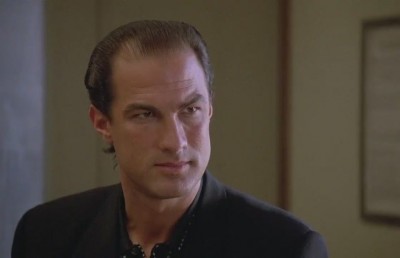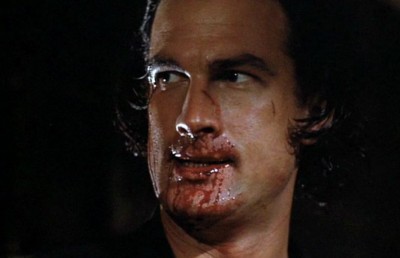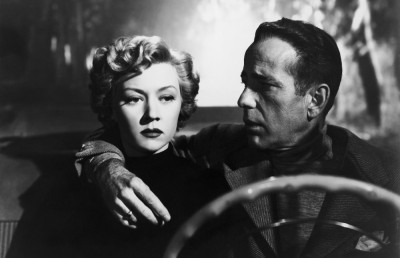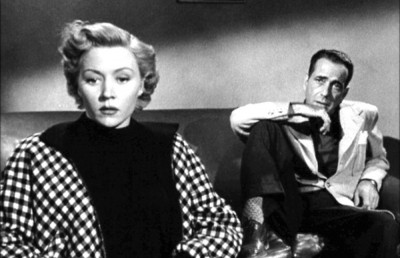The Art Of Dying: Point Blank (John Boorman, 1967)
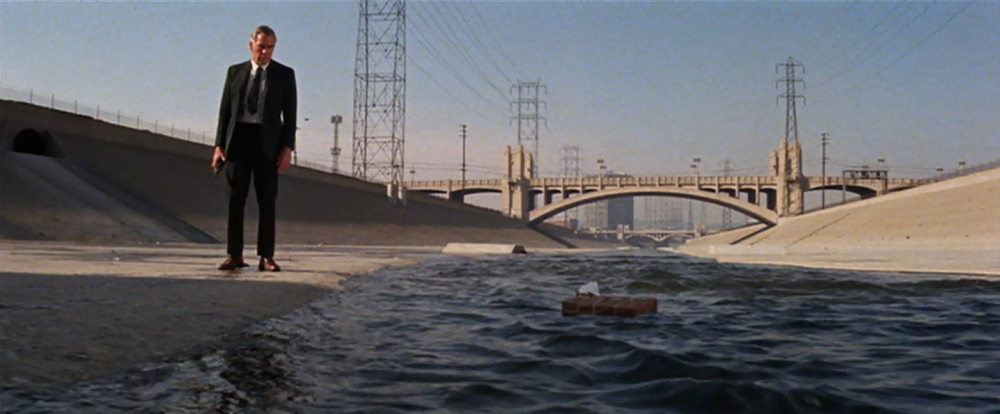
Introduction
Point Blank (John Boorman, 1967) is a crime film that centres on Walker (Lee Marvin), a violent criminal who seeks vengeance when his friend and partner in crime Mal Reece (John Vernon in his first feature film role) double-crosses him after a robbery at the old disused prison on Alcatraz Island in San Francisco Bay. Reece shoots Walker at point blank range, leaving him for dead, convulsing in the corner of one of the prison cells. Reece then takes Walker’s share of the robbery money ($93,000). He also takes Walker’s wife Lynne (Sharon Acker). Yet Walker somehow manages to survive the gunshot wounds. Seemingly recovered, Walker rampages through the remainder of the film seeking revenge for the betrayal of his friend and his wife. He also wants to retrieve the $93,000 he is owed from the robbery.
On one level, Point Blank can be viewed as a straightforward story about betrayal, vengeance and greed. On closer viewing, however, Point Blank possesses a surreal disorientating dreamlike quality. On another level, Point Blank can be interpreted as the dream of a dying man. A dying dream experienced by Walker, from the moment he is shot by Reece at the beginning of Point Blank and left to die in a dank prison cell at Alcatraz, until the final frame of the film. Point Blank utilizes a dizzying of innovative visual, editing and sound techniques, as well as a fractured and disorientating narrative structure, all of which reinforce the notion of a blurring between dream and reality.
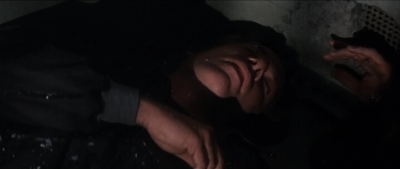
Alive? Sleeping? Dying? Dreaming? All of the above?
Point Blank was British director John Boorman’s debut feature film in Hollywood. An adaptation of a hardboiled crime novel called The Hunter, written in 1962 by Richard Stark (a pseudonym for the author Donald E. Westlake), Point Blank is a very courageous, ambitious and experimental film, particularly for a young (34 year old) director with no prior experience in Hollywood. Moreover, Point Blank was not a box office success when it was originally released in 1967. With it’s fractured, disorientating dreamlike narrative structure, the film never really caught on with audiences at the time. However, over the years, the influence and the reputation of Point Blank has continued to grow. The film has attained a significant cult status among discerning cinema audiences, as well as capturing the attention of other filmmakers. Indeed, Point Blank was re-made as Payback (Brian Helgeland, 1999) starring actor and director Mel Gibson. While Payback intensives the violence, it has a straightforward revenge narrative, and lacks the cinematic virtuosity, as well as the dreamlike fractured narrative quality of Boorman’s original version.
In the years since Point Blank, John Boorman has had a substantial career. He has directed a number of other notable films, both in Hollywood and Britain including, Hell in the Pacific (1968), Deliverance (1972), Hope and Glory (1979), Excalibur (1981) and The General (1998).
John Boorman in Hollywood
John Boorman began his career making television documentaries for the BBC in London, before directing his first feature film Catch Us If You Can in 1965 (the film was re-titled Having a Wild Weekend in the US). Influenced by the irreverence, the creativity and the spontaneity of A Hard Day’s Night (Richard Lester, 1964), which starred the Beatles, Catch Us If You Can features the Dave Clark Five, another popular British group of the time. The members of the Dave Clark Five are cast as a team of stuntmen working on a series of TV commercials. One of the stuntmen, Steve (Dave Clark), meets and runs off with Dinah (Barbara Ferris), a model whose face appears in an advertising campaign for meat. Catch Us If You Can also features several original songs written by the Dave Clark Five, including the film’s title track. Location scenes in London also capture the city at a point in the mid-1960s when it was just starting to swing. Although by his own admission a minor work, Catch Us If You Can was successful enough, both critically and commercially, for Boorman to gain recognition in Hollywood. [1] Boorman also recalls that the respected American film critic Pauline Kael had seen Catch Us If You Can (AKA: Having a Wild Weekend), and had praised the film in a review. Moreover, such was the influence of Kael that her positive remarks about Catch Us If You Can led to Boorman receiving offers in Hollywood. [2]
Importantly, Point Blank was made at a time of considerable change in Hollywood. By the mid-1960s the big Hollywood studios, including MGM (which was to release Point Blank) were struggling to compete with the popularity of television. The studios had been relying on the promise of lavish screen spectacles to win back their audience. But a series of big-budget financial disasters, such as Cleopatra (Joseph L. Mankiewicz, 1963) had created a sense of uncertainty and anxiety for the Hollywood studios. At the same time, the popularity of European films shot on much smaller budgets, were proving popular with film audiences overseas. [3] As Boorman recalled, “All these American producers were camping out in London, trying to make pictures because there was a feeling that somehow the younger European directors knew how to attract an audience.” [4]
Significantly, the emergence of the French New Wave in the late 1950s and early 1960s, and directors like Jean Luc Godard and Francois Truffaut were to have a profound influence on many young directors such as John Boorman. Point Blank, although undoubtedly identifiable as an American gangster film, also has a very European appearance, particularly in its innovative use of a fragmented narrative structure.
As Boorman began to gain recognition in Hollywood, he came to the attention of MGM, as well as Judd Bernard, a Hollywood press agent (who was to co-produce Point Blank with Bob Chartoff and Irwin Winkler). Bernard had seen Catch Us If You Can and was impressed enough to set up a meeting between Boorman and Lee Marvin, who was in London at the time filming The Dirty Dozen (Robert Aldrich, 1967). [5] As Boorman explained, “….I met the producer, Judd Bernard; he showed me a script, which was dreadful, but whose hero fascinated me. He’d also given it to Lee Marvin. A few months later, I met Marvin in London, where he was filming The Dirty Dozen. He felt as I did about the script and, though he’d seen none of my films, he asked me if I’d like to make this one with him”. [6]
As a young director making his first film in Hollywood, Boorman was extremely fortunate to be working with a major star of Lee Marvin’s stature. Marvin was at the height of his Hollywood stardom in 1967. He had just won an Oscar for the dual roles of the ruthless killer Tim Strawn and the boozy gunslinger Kid Shelleen in the musical spoof western Cat Ballou (Elliot Silverstein, 1965). Such was Marvin’s clout in Hollywood at the time that he was able to call a meeting with the head of MGM, with his agent, and the producers of Point Blank. In this meeting Marvin told them that he had script approval, as well as approval of the principle cast, and that he was going to defer those approvals to Boorman. In his very first film in Hollywood, Boorman was in the enviable position of having final cut. Nevertheless, Boorman recalls that when Point Blank was finished and he showed it to the executives at MGM, they were all very perplexed. There were also mumblings about re-shoots. However, the legendary Margaret Booth (who had been an editor in Hollywood since the silent days) was also at the screening. She said to Boorman as the executives were filing out, “You touch one frame of this film over my dead body.” Boorman remembers that Booth made a couple of very minor suggestions, which were very helpful, and the film was released without any cuts. [7]
Over the years, John Boorman has emphasized that Point Blank is very much a study of Lee Marvin. Born in 1924, Marvin joined the Marines as an impressionable 17 year old and fought in the Pacific War. Marvin was to be brutalized by his war experiences. The Japanese ambushed his platoon during the Battle of Saipan in 1944. Marvin was shot and wounded in the buttocks by Japanese fire. As Boorman explains, “His whole platoon was wiped out, except for one other person. And he felt himself to be a coward lying there, and he never lost that. It was survival guilt – and it didn’t help that he had been shot in the arse. Not because he was running away, but because he was lying down when he was wounded.” [8] Boorman maintains that, in one sense, Point Blank is about Lee Marvin. A connection can be made between the brutality of Marvin’s traumatic war experiences and the way in which he expresses himself through violence on the screen in Point Blank. Boorman points out that Marvin was always trying to recapture the humanity he felt he had lost during his war experiences. The story in Point Blank is all about Marvin trying to recapture this humanity. In the film Marvin (Walker) is a dead man. He comes back (or appears to come back) from the dead and tries to find his humanity. [9]
After Point Blank, Boorman and Marvin remained close friends (until Marvin’s death in 1987). The film Boorman made after Point Blank, Hell in the Pacific, also starred Lee Marvin. Set during the Second World War, Hell in the Pacific is a film that echoes Marvin’s own traumatic war experiences. Marvin plays an unnamed American pilot who is marooned with a Japanese navy captain (Toshiro Mifune) on a small-uninhabited island in the Pacific Ocean. In addition, Boorman also made a television documentary in 1998 about Marvin entitled: Lee Marvin: A Personal Portrait by John Boorman.
Boorman’s original intention was to make Point Blank entirely in San Francisco. However, after visiting San Francisco for the first time Boorman realized it wasn’t the kind of locale that he wanted for the film. As he explains, “I’d never been there, but when I saw the city, I realized it wasn’t at all the kind of setting I was looking for. It was all soft, romantic, pastel shades – a very beautiful place – but the complete opposite of what I wanted for the film. I wanted my setting to be hard, cold and, in a sense, futuristic. I wanted an empty, sterile world, for which Los Angeles was absolutely right.” [10] But Boorman had to fight against the studio, against the producers, and even against the screenwriter Alexander Jacobs to get his way. He finally won out because filming in Los Angles was going to be less expensive. [11] Ultimately, Point Blank was made for a modest 3 million US dollars. [12]
A Fragmented, Dreamlike Narrative Structure
From the first frame of Point Blank, a variety of innovative cinematic techniques are brilliantly utilized, all of which reinforce the notion of a blurring between dream and reality. Point Blank was also Boorman’s first colour film. Boorman and cinematographer Philiip H. Lathrop use a 40 mm Panavision widescreen lens and low-key lighting throughout Point Blank. Boorman has emphasized that he favoured the wide-angle lens because it allowed for a greater depth-of-field, providing the viewer with enough clarity to see what was going on in the background of the frame, without distracting from the close-ups in the foreground. [13] Complex editing techniques, as well as a multi-layered soundtrack (by composer Johnny Mandel) also envelope the viewer, further enhancing the dream-like atmosphere in Point Blank. Multiple intercuts between the past and the present, sudden outbursts of unanticipated violence, repeating scenes already shown (so that events that are happening to Walker appear to have happened before), as well as the innovative use of sound: the minimalist score, various sound affects, and the use of voiceover, all create a fragmented dreamlike narrative, which disorientates the viewer.
Within the first five minutes of Point Blank, Boorman plays with the temporal structure of the narrative, flashing backwards and forwards in time on numerous occasions. The first frame of the film momentarily reveals Walker’s face (although the viewer doesn’t yet know who he is). He is squinting, his face distorted by coloured lights. Then the sound of loud gunshots ring out, and the film suddenly cuts to the darkness of an old jail cell in the disused prison on Alcatraz Island. A man (Walker) has been shot. He slumps to the floor in the corner of the cell, twitching. Emphasizing this dreamlike atmosphere, Walker’s voiceover can be heard muttering, “Cell. Prison cell. How did I get here?” The film then cuts again, flashing back to a crowded and noisy room. Among the throng are two men (Walker and Reece). An aggressive Reece grabs a drunken Walker, punches him, and they wrestle to the ground. Then another cut, this time flashing forward once more to Alcatraz. It’s now daylight. Lynne is in the foreground as Walker and Reece plan the robbery. There is a further cut, back to the night scene at Alcatraz with Reece shooting and killing the two men who have made the drop, delivering the money by helicopter. Then another cut, back once again to the jail cell with Reece shooting Walker. In a possible reference to Walker’s dreamlike state, his voiceover is heard once again as he utters, “Did it happen? A dream. A dream”. These scenes are overlaid with Johnny Mandel’s eerie score, an off key drone, what sounds like a high pitched female voice, which further emphasizes the otherworldly atmosphere of the film.
Following the rapid intercutting of the opening scenes at Alcatraz, there is an abrupt cut; suddenly it’s daylight outside the prison. Walker, who has seemingly survived the ordeal, emerges from the San Francisco Bay, staggering over rocks, wet and bedraggled. Then there is another sudden cut to Walker leaning over the side of a boat, gazing expressionlessly across at Alcatraz. He appears to have now fully recovered from his wounds, and is dressed smartly in a crisply pressed light grey suit. Over a loudspeaker on the boat, there is a recorded commentary detailing the history of the prison on Alcatraz Island. The commentary is emphasizing how Alcatraz prison was virtually escape proof (located about 2.4 kilometres offshore from San Francisco, the notorious maximum security prison housed some of America’s most dangerous criminals between 1934 to 1963, including gangster Al Capone and murderer Robert “Birdman of Alcatraz” Stroud. Alcatraz is also known as “The Rock” due to its impenetrability). Officially, no one has ever succeeded in successfully escaping from Alcatraz. However, Walker seems to have accomplished the near impossible and escaped. Or has he? This lingering question about whether or not Walker did survive provides his character with a mythic quality until the last frame of the film. Is this a story that’s happening in Walker’s mind? Or is this real life?
The dreamlike atmosphere in Point Blank is further enhanced by the mysterious presence of Yost (Keenan Wynn), who suddenly appears at certain points throughout the film without any explanation. The first time Walker meets the mysterious Yost is on the boat circling Alcatraz. Walker has not only inexplicably escaped from Alcatraz, but the film seems to have jumped ahead in time (how much time is never made clear). Materializing out of nowhere, the first words Yost utters are, “How did you get out Walker?” The nature of the conversation between Walker and Jost on the boat also seems to have a dreamlike and surreal element to it. Although the two men both appear together in the same frame, they hardly ever glance at each other, and the nature of their conversation appears detached. Moreover, their verbal exchanges are delivered in a clipped, staccato fashion.
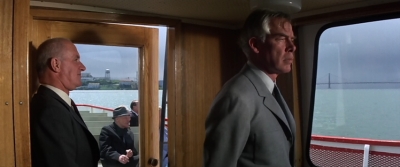
Keenan Wynn as the mysterious Yost
Yost informs Walker that Reese has used the rest of the money to buy his way back into “The Organization”, a crime syndicate that masquerades as a legitimate business empire, the purpose of which is never made clear. Yost says he’ll help Walker find Reese. But Walker must help him track down the Organization. Yost provides Walker with Lynne’s address in Los Angeles, where she has been living with Reece. While the character of Yost is integral to the film’s narrative (he wants Walker’s help to destroy the Organization), Boorman presents him as a kind of apparition, an otherworldly figure within the landscape who appears without warning. [14]
Point Blank then shifts from Alcatraz and the San Francisco Bay to the cold, concrete sterility of Los Angles. The following scene brilliantly utilizes intercutting techniques and sound effects to disorientate the viewer by creating a fragmented time-frame, while simultaneously building tension and further enhancing the dreamlike aura of the film. Walker has arrived at Los Angeles airport on-route to the apartment where Lynne (Sharon Acker) has been staying with Reece. The film intercuts back and forth in time between Walker marching purposely through the airport tunnel, Lynne in bed in the apartment and at the hairdressers, as well as scenes of Walker driving to the apartment and waiting in the car for Lynne to return. Overlaid with these various scenes are the sounds of Walker’s footsteps in the airport tunnel, which increase in intensity as the scene progresses. The sound of Walker’s footsteps is augmented by the otherworldly score; what sound like electronic beeps, more tonal than melodic, which adds to the otherworldly atmosphere of the film. The sound of the footsteps progressively become more pronounced, culminating with Walker bursting through the door of the apartment and grabbing Lynne, gun drawn, as he looks both left and right, searching for Reece. Walker then lurches into the bedroom and unloads several shots from his Smith & Wesson into the empty bed.
After this outburst of violence, and with Reece nowhere to be found, Walker collapses on the sofa; spent. The gun is dangling from his finger, with the bullets from the chamber having been emptied onto the coffee table in front of him. A dazed Lynne sits down beside Walker on the sofa. Boorman recalls that when this scene was being rehearsed, Marvin didn’t ask Sharon Acker the questions that were in the script. Questions like: Where is Reece? Where is the money? He just sat on the sofa, motionless. As Boorman explains, “Lee never made suggestions. He would just show you.” [15] Consequently, Boorman altered the dialogue in this scene, so that Lynne supplied both the questions and the answers without Walker uttering a word. It gave what would have been a conventional scene a much more abstract emphasis. [16]
Also notable in this scene is the colour of the set design. Both the clothes worn by Walker and Lynne, as well as the colour tones of the furniture and the curtains in the lounge room of the apartment consist of various shades of grey. Boorman points out that he decided to begin Point Blank by using cold colours, with each scene incorporating one particular colour scheme. As the film progresses, these colours gradually warm up. [17] For example, later in Point Blank there is a scene that takes place in the office of the Organization. The Organization’s henchmen all wear suits in various shades of green. The décor in the office is also in a range of green hues. Towards the end of the film there are scenes in which Walker wears a brown suit and a dark yellow shirt, with the sets also containing variations on the same colour scheme. By the end of Point Blank, Walker’s suit jacket and shirt are a reddish colour. Boorman emphasizes that, while these various colour schemes within scenes provide Point Blank with a sense of unity, they also give the film a kind of stylized look; the impression that the events taking place are not quite real. [18] Significantly, Boorman has cited Italian director Michelangelo Antonioni’s Red Desert (1964) as a major influence on his use of colour for the set designs in Point Blank. [19]
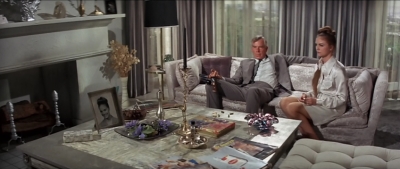
Antonioniesque use of color
The scenes that follow Walker and Lynne on the sofa involve an even more surreal and disorientating series of cuts. A little later in the film there is a cut to Walker stretched out on the sofa. He is alone and the room is in darkness. In what appears to be a dream, there is a flashback to Walker again crashing through the door of the apartment and grabbing Lynne, with his gun drawn. However, this time the scene is in slow motion. The scene is then repeated again. Suddenly, Walker wakes up. He goes back to the bedroom. There he finds Lynne splayed face down on the bed. She is dead, having overdosed on sleeping pills.
Walker then returns to the lounge room, pulls back the blinds, and squinting in the sunlight, sees Yost outside (who again appears without any explanation). Yost is standing, looking in Walker’s direction and pointing towards him. Walker goes back into the bedroom and finds it empty. Lynne has disappeared, the sheets and bedding have gone, and there is a cat lying at the end of the bed. After going into the bathroom, Walker comes back into the lounge room and all the furniture is gone. He then goes to the corner of the lounge room and crouches on the floor, staring blankly into space. Boorman explains that, with this scene, he tried to make the corner of the room look like the jail cell at Alcatraz. [20] As Walker crouches down, the window behind him is covered in what look like prison bars (throughout the film there are horizontal blinds and screens, which often enclose the characters within the frame. Further references to the jail cell at Alcatraz perhaps?). Suddenly, the sounds of gunshots ring out. Walker looks from left to right. The same eerie high-pitched sound of a woman’s voice, which is heard at the beginning of the film at Alcatraz, is once again audible. There is also a brief snippet of Reece’s voiceover, speaking to Lynne in the jail cell at Alcatraz just before he shoots Walker. These sounds appear to be going on inside Walker’s head. Could it be that Walker is still in that jail cell at Alcatraz, hovering between life and death?
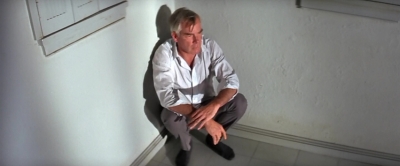
When discussing how the above scenes originated, Boorman hints at the possibility that Point Blank is actually a dream which Walker is experiencing as he lies dying in the jail cell at Alcatraz. As Boorman explains, “Whenever I meet cine-literate directors like Brian De Palma, they always ask me how I filmed the scene in which Walker returns to his wife’s apartment and, in the following scenes, all the furniture has disappeared. It’s so strange and mysterious, it couldn’t have been written into the script. In fact, it was while Lee and I were talking, during the shoot, that the idea came to us. He suddenly sat down in a corner of the empty room, as though he were back in his cell in Alcatraz. It’s in that sense that, for me, the set is not ‘realistic’: I changed it so that it would correspond to the character’s state of mind.” [21]
The “Walking Dead”
Throughout Point Blank Walker’s expressionless granite-like ‘Easter-island’ face appears edged in stone. Walker is the embodiment of the ice-cold, disembodied robotic killer (although it’s worth noting that, although Walker beats up a few of the thugs from the Organization and roughs up Reece, he doesn’t actually kill anyone during the film). Walker seems to possess an otherworldly detachment from the action that is taking place around him. A scene that exemplifies the detached and violent nature of Walker’s character takes place after he follows the Organization’s henchmen to a music club called the Movie House. In front of a kaleidoscopic backdrop of psychedelic colours, a gritty black soul singer is screeching on the small stage. The incessant and repetitive rhythm of the music is combined with the atonal screech of the singer, who is encouraging the audience to join him in a call and response by thrusting the microphone in their faces. Walker seems oblivious to what is happening on the stage. Moreover, when Walker speaks to the waitress in the club, who remembers him, he appears emotionally detached, and his dialogue is perfunctory. Walker is then involved in a brutal fight behind the stage with the Organization’s henchmen. Walker seems dazed; squinting in the harsh psychedelic colours of the club lights. He breaks a bottle over the head of one of the henchmen and punches another one in the groin. What is taking place behind the stage cannot be heard over the cacophony out front. Even when one of the dancers on stage witnesses the brutality backstage, her scream is inaudible over the din.
The only moments in the film when Walker breaks into a smile are in the flashback sequences, before he is shot at Alcatraz and left to die. For example, there is a flashback to happier times, with a younger, dark haired, more playful Walker encircling Lynne on a pier in a kind of courtship dance, surrounded by smiling sailors. His persona is engaging, and his body movements are looser. In the same flashback sequence, Walker greets his friend Reece across a crowded room and they warmly embrace. In these scenes, Walker actually appears to be human. It is a stark contrast to the character of Walker that dominates the film, an expressionless, detached, unemotional figure who resembles the “walking dead”.
In a later scene, Walker tracks down Lynne’s sister Chris (Angie Dickinson). He convinces her to help him take revenge on Reece, who has relocated to the Penthouse Suite of the Huntley House, a hotel and apartment complex run by the Organization (Ironically, Walker doesn’t end up killing Reece, who accidently dies when he plummets naked from the hotel penthouse balcony to the street below.). Another example of Walker’s detachment from the world around him, as well as his inability to connect on any emotional level, is personified in a scene after the film shifts to the house of one of the Organization’s bigwigs, Brewster (Carroll O’Connor). In frustration, Chris repeatedly slaps Walker, trying to get a reaction out of him. He just stands in front of her, granite-like, and takes the beating without flinching or reacting in any way. When Chris finishes, collapsing from exhaustion in a crumpled heap on the floor, Walker methodically straightens his suit, walks over and sits on the couch. He calmly picks up the remote control and turns on the TV, flicking through the stations and starring impassively at the screen.
The Dream of a Dying Man
Towards the end of Point Blank Walker meets with and demands his $93,000 from Brewster. In a neat symmetry, the final scenes of Point Blank (which were shot at Fort Point, an old Spanish Fortress in the shadows of the Golden Gate Bridge), like the beginning of the film, involve a money drop delivered by helicopter. A package is delivered that appears to contain the money that Walker has been so desperate to get his hands on. However, its contents are never revealed because Walker fails to collect the package. As the scene progresses, Walker fades further away into the shadows until he disappears from view completely. It seems like he has ceased to exist. Does Walker disappear because he fears it’s a setup and he will be killed? The hit man seen earlier in the film (James Sikking) is lurking in the darkness with a rifle. He shoots and kills Brewster. Does he also intend to kill Walker as well? Once again, Yost appears without explanation, emerging from the shadows. In a clever twist, it also appears as if Yost may actually be Fairfax, the top man in the Organization (although it is still not clear if Yost/Fairfax really does exist at all). As Brewster is dying he looks up at Yost/Fairfax and blurts out, “This is Fairfax Walker! Kill him!” Yost/Fairfax then replies, “Brewster was the last one. Thought he could take over from me.”
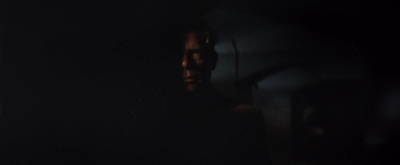
Walker slipping into darkness
There are many questions left unanswered at the conclusion of Point Blank. However, the surreal atmosphere of Point Blank, as well as its disorientating narrative structure certainly suggests that the entire film, from the moment Walker is shot by Reece at Alcatraz, until the very last frame, has been the dream of a dying man, lying wounded and convulsing on the floor of a dank prison cell. Indeed, the last scene in Point Blank seems to reinforce the notion of “it was all a dream”. Shot from Fort Point, the camera pans up and across to the shadowy ominous spectre of Alcatraz. The camera continues to press closer to Alcatraz as the end credits start to roll. Is this shot the final indication that Walker has now ceased to exist? Has he died in that prison cell at Alcatraz?
Endnotes
1 Brian Hoyle, The Cinema of John Boorman, Rowman & Littlefield, 2012, p.27.
2 Commentary by John Boorman and Stephen Soderbergh, Point Blank DVD, Warner Home Video/Turner Entertainment, 2005.
3 Hoyle, p.28.
4 Hoyle, p.29.
5 Hoyle, p.29.
6 Michel Ciment, John Boorman, London: Faber, 1986, p.72
7 Commentary by John Boorman and Stephen Soderbergh, Point Blank DVD.
8 Philip Kemp, ‘Return to Zero’, Sight and Sound, London: British Film Institute, June 1998, p. 12.
9 Commentary by John Boorman and Stephen Soderbergh, Point Blank DVD.
10 Ciment, p.73
11 Ciment, p.73.
12 Spicer, Andrew, Historical Dictionary of Film Noir, Scarecrow Press, 2010, p. 236.
13 Commentary by John Boorman and Stephen Soderbergh, Point Blank DVD.
14 Ciment, p.73.
15 Commentary by John Boorman and Stephen Soderbergh, Point Blank DVD
16 Commentary by John Boorman and Stephen Soderbergh, Point Blank DVD.
17 Commentary by John Boorman and Stephen Soderbergh, Point Blank DVD.
18 Commentary by John Boorman and Stephen Soderbergh, Point Blank DVD.
19 Commentary by John Boorman and Stephen Soderbergh, Point Blank DVD.
20 Commentary by John Boorman and Stephen Soderbergh, Point Blank DVD.
21 Ciment, p.72.



